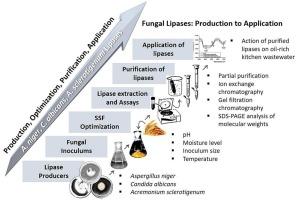Purification of optimally produced extracellular fungal lipases and their role in the remediation of oil-rich kitchen wastewater
IF 1.9
4区 生物学
Q4 BIOCHEMICAL RESEARCH METHODS
引用次数: 0
Abstract
Wastewater containing oils and lipids can have major environmental consequences, such as water contamination, soil erosion, and harmful impacts on ecosystems and aquatic life. Therefore, to eliminate oils and fix these discharges for the benefit of the environment, proper treatment of wastewater is essential. In this regard, lipases can be applied to a variety of domestic and commercial wastewater biotreatment applications. Lipases in the current study were produced using A. niger (MG654699.1), C. albicans (ATCC10231), and A. sclerotigenum (MK732096.1). The SSF optimization revealed that the highest quantity of lipase was generated for selected strains at 30 °C along with an optimized size of inoculum and moisture content, i.e., 5 mL, and at pH 7 in the case of A. niger and C. albicans and pH 8 in the case of A. sclerotigenum. The A. niger lipase after purification showed a specific activity of 42.7 Umg−1, fold purification of 2.29, percentage yield of 57.5 %, and molecular weight of 30 kDa. The C. albicans purified lipase exhibited a specific activity of 35.6 Umg−1, a fold purification of 2.42, a percentage yield of 56.4 %, and a molecular weight of 45 kDa. The purified lipase from A. sclerotigenum showed a specific activity of 38.5 Umg−1, a fold purification of 4.35, a percentage yield of 57.7 %, and a molecular weight of 80 kDa. The degradation of oil-rich wastewater by fungal lipases was confirmed by the FTIR analysis of the control and lipase-treated kitchen wastewater samples. The results showed that these fungal lipases could be used in the bioremediation of wastewater with significant amounts of oils and lipids.

最佳产胞外真菌脂肪酶的纯化及其在富油厨房废水修复中的作用。
含有油脂的废水会造成严重的环境后果,如水污染、土壤侵蚀以及对生态系统和水生生物的有害影响。因此,为了消除油类并修复这些排放物以造福环境,对废水进行适当处理至关重要。在这方面,脂肪酶可以应用于各种生活和商业废水的生物处理应用。本研究中的脂肪酶是由黑曲霉(MG654699.1)、白色念珠菌(ATCC10231)和硬核念珠菌(MK732096.1)产生的。SSF优化结果表明,所选菌株在30 °C、最佳接种量和水分含量为5 mL时脂肪酶产量最高,黑曲霉和白色念珠菌的pH为 7,菌核念珠菌的pH为 8。纯化后的黑曲霉菌脂肪酶比活性为42.7 μ g-1,倍纯化率为2.29,产率为57.5 %,分子量为30 kDa。所得白念珠菌脂肪酶的比活性为35.6 μ g-1,纯化倍数为2.42,产率为56.4% %,分子量为45 kDa。该酶的比活性为38.5 μ g-1,纯化倍数为4.35倍,产率为57.7 %,分子量为80 kDa。通过对对照和经脂肪酶处理的厨房废水进行红外光谱分析,证实了真菌脂肪酶对富油废水的降解作用。结果表明,这些真菌脂肪酶可用于含油脂废水的生物修复。
本文章由计算机程序翻译,如有差异,请以英文原文为准。
求助全文
约1分钟内获得全文
求助全文
来源期刊

Journal of microbiological methods
生物-生化研究方法
CiteScore
4.30
自引率
4.50%
发文量
151
审稿时长
29 days
期刊介绍:
The Journal of Microbiological Methods publishes scholarly and original articles, notes and review articles. These articles must include novel and/or state-of-the-art methods, or significant improvements to existing methods. Novel and innovative applications of current methods that are validated and useful will also be published. JMM strives for scholarship, innovation and excellence. This demands scientific rigour, the best available methods and technologies, correctly replicated experiments/tests, the inclusion of proper controls, calibrations, and the correct statistical analysis. The presentation of the data must support the interpretation of the method/approach.
All aspects of microbiology are covered, except virology. These include agricultural microbiology, applied and environmental microbiology, bioassays, bioinformatics, biotechnology, biochemical microbiology, clinical microbiology, diagnostics, food monitoring and quality control microbiology, microbial genetics and genomics, geomicrobiology, microbiome methods regardless of habitat, high through-put sequencing methods and analysis, microbial pathogenesis and host responses, metabolomics, metagenomics, metaproteomics, microbial ecology and diversity, microbial physiology, microbial ultra-structure, microscopic and imaging methods, molecular microbiology, mycology, novel mathematical microbiology and modelling, parasitology, plant-microbe interactions, protein markers/profiles, proteomics, pyrosequencing, public health microbiology, radioisotopes applied to microbiology, robotics applied to microbiological methods,rumen microbiology, microbiological methods for space missions and extreme environments, sampling methods and samplers, soil and sediment microbiology, transcriptomics, veterinary microbiology, sero-diagnostics and typing/identification.
 求助内容:
求助内容: 应助结果提醒方式:
应助结果提醒方式:


